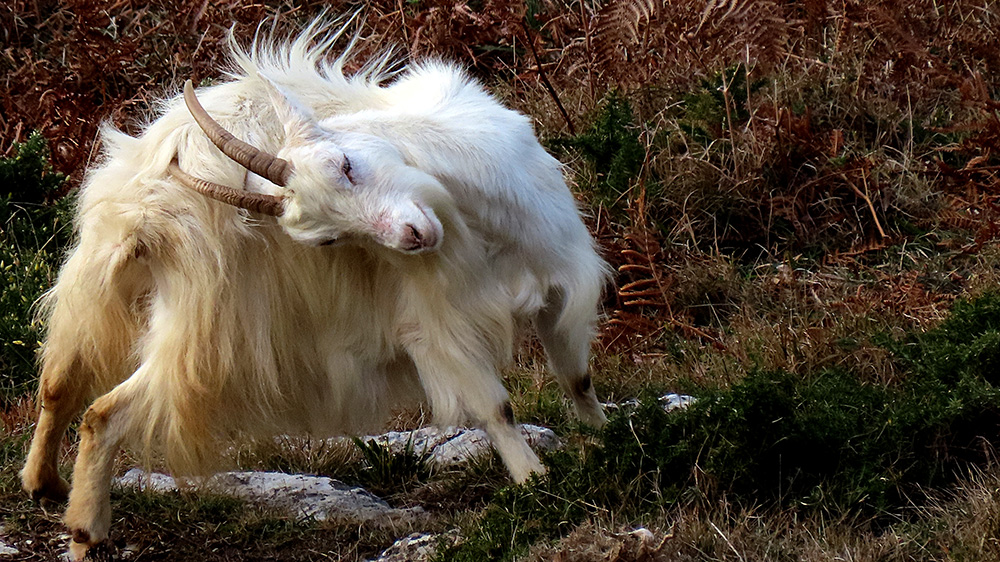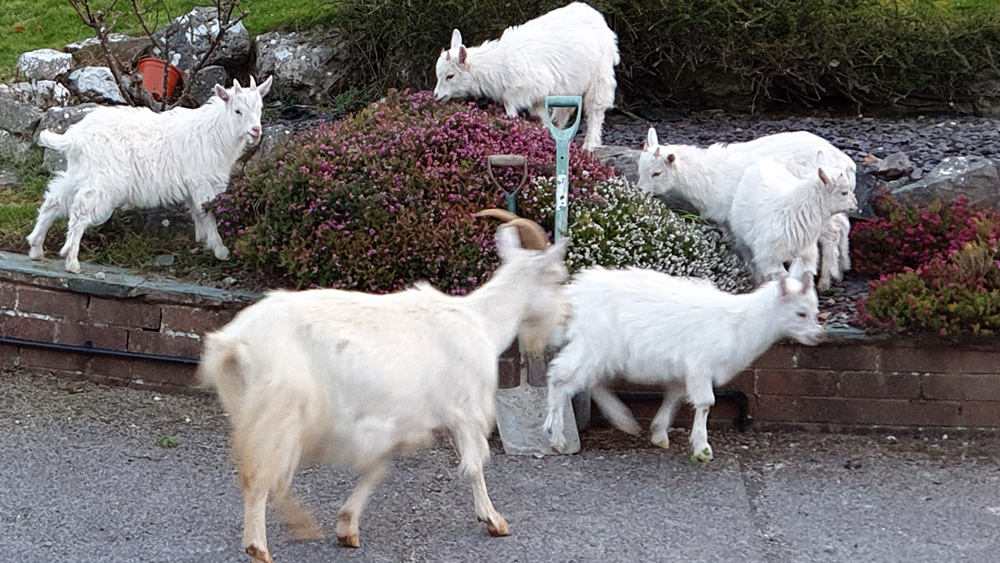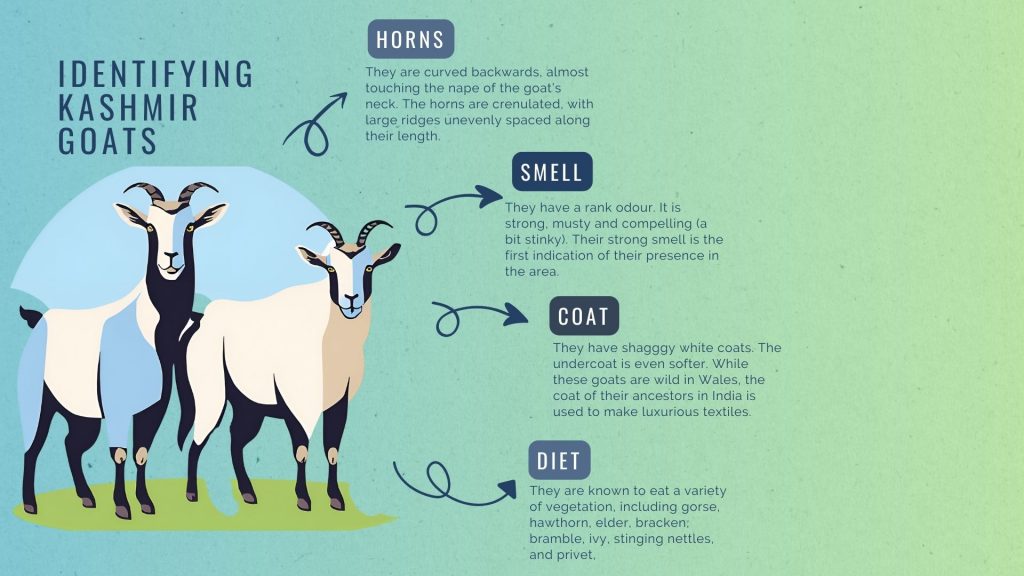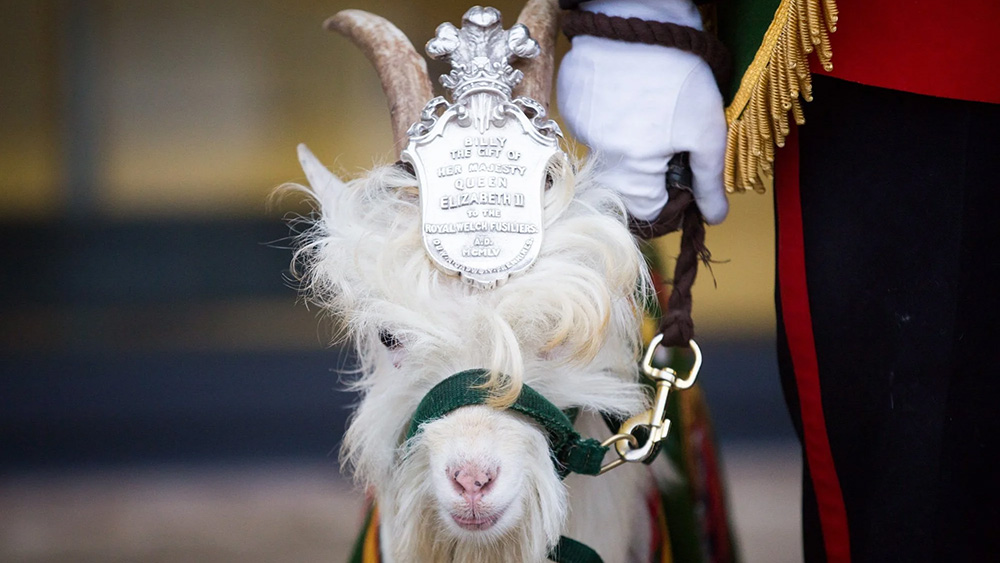The goats made international headlines during the pandemic by behaving like gangsters. How have Llandudno residents adapted to living alongside them?

On a spring morning, Louise Emery and her kids were excited to soak up the sun in their garden. The tulips had just begun to bloom, and the family was proud of how beautifully the place had been maintained. However, a gangster with curved horns and a shaggy white coat had other plans.
As Louise opened the door, there he was, devouring one of her precious tulips. The Kashmiri stood with his gang, staring into her eyes and claiming browsing rights over her plants.
“You have to make your garden like Jurassic Park to stop these goats from coming in,” says Louise. “Every day, from January to April, they are in my garden. I wake up and I can hear the little baby kids bleating, and I’m going, ‘Oh, no’.”
When the Coronavirus pandemic forced everyone to stay in their homes and maintain distances of six feet, gangs of Kashmiri Great Orme goats invaded Llandudno, a coastal town in North Wales known for its beach and Victorian architecture.
The goats left the headland of Great Orme and broke into shops and houses. They perched on walls, nibbled onto anything they wanted and pooped everywhere.
Five years later, locals still complain about frequent damages to property and gardens as the goats are often out on in the town for a stroll or a midnight munch.

Many residents have given up planting roses, tulips and cordyline because the goats love them. Instead, they are growing more lavenders, which these animals hate.
“They don’t like the smell of lavender,” says Louise, who is also the councillor for Llandudno and chairwoman of the Great Orme Management Committee. “All the areas in my garden that I want the goats to avoid, I’ve got a whole load of lavender around it. And then I use chicken wire if I’m growing a small plant or something.”
Louise receives numerous complaints every week about the ruckus created by the goats, but she says the council can do little as they are wild animals.
“I was looking at one this very morning from somebody who lives next door to like a rough bit of ground or a building site near the Great Orme. They wanted the owners of the ground to fence it all to prevent goats from coming in. But the builders said they are not going to do that. And the goats are then getting into next door and eating all their lovely bulbs,” she says.
The council argues they are not legally responsible for keeping the goats contained at the Great Orme and if damage is being caused to properties, it is the owner’s responsibility to keep the animals out.
“A land owner has a legal entitlement to act on behalf of an animal’s welfare, if a wild animal is in distress whilst on their land. The Council may also act to control populations of wild animals that reside on its land, where those animals are not protected by law and by means that are not prohibited by law,” says the council’s goat management plan.

The history of Kashmiri goats into Europe can be traced back to over 200 years ago when they were brought to France from Persia. In 1837, Queen Victoria was presented with a pair of them by the Shah.
Seven years later, Queen Victoria presented the Royal Welsh Fusiliers with the first Kashmir goat mascot, starting the tradition of the reigning monarch providing the mascot.
They came to Wales when she gifted a pair of them to a local landowner, Major General Sir Savage Lloyd-Mostyn, in the 1890s, when he finished serving as Colonel of the Royal Welsh Fusiliers.
Over the years, their population increased and by this millennium, there were over 200 of them, living in a wild state. Contraceptive measures brought down the number to around 120, but during the pandemic, it surged again and is estimated to be around 200 now.
The goats move to Llandudno and other areas during harsh winters when grass and vegetation on the Great Orme become scarce. Strong winds and storms can also drive them toward lower, more sheltered areas in town. However, they go back as the weather changes and the conditions improve.

On 26th March 2020, Andrew Stuart, 36, was sitting in his parents’ dark, empty pub, in Llandudno, gulping down the free beer and staring into the windy night, when he saw a tribe of around 20 goats run past the window. He thought he was seeing things. To be sure, he started recording videos.
“I was like, this is very unusual, very weird and very funny at the same time because I had never seen goats do this,” says Andrew. “I called the North Wales police number to let them know there was a group of goats running around the streets.”
Soon enough, the police car was on the streets to control the rioting goats.
The next day, Andrew tweeted the videos and pictures on his Twitter accounts, and it blew up. First, a few local publications picked up the story, then the national ones, and finally, the news of the uprising went global. Even American comedian Ellen DeGeneres wanted to meet these raiders.
“It was just like nature taking back control. And people loved it,” says Andrew whose Twitter bio describes him as the accidental goat correspondent.

A group of these goats discovered the Little Orme, in the east of the town and found food there. But even as the weather improved, they did not want to go back to the Great Orme.
“Some of them were removed, brought back to the Great Orme, fenced in for a few weeks to see if they will, like, heft themselves back. They were spray painted with red paint to know which were released. And guess what happens? About four or five weeks later, went back,” says Louise.
Andrew and Louise both agree the popularity of the goats is bringing tourism to the town and has proved a great asset, but they are also worried about these uncontrollable and yet docile creatures.
“I am worried about the little ones. They have grown among humans. There is no natural barrier now between them living in the Great Orme and us living here. And these little ones often wander off. They are wild goats, and we need to figure out how to keep them in the wild,” says Andrew.
